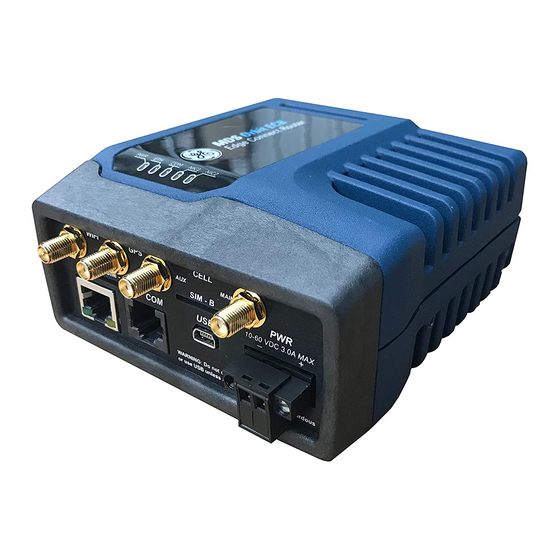
GE MDS ORBIT MCR Manuals
Manuals and User Guides for GE MDS ORBIT MCR. We have 1 GE MDS ORBIT MCR manual available for free PDF download: Technical Manual
GE MDS ORBIT MCR Technical Manual (464 pages)
Multiservice/Edge Connect Routers
Brand: GE
|
Category: Network Router
|
Size: 12.03 MB
Table of Contents
-
-
-
MCR-4G Unit16
-
ECR-900 Unit16
-
-
Introduction16
-
Thi Manual17
-
-
-
Key Features19
-
-
-
-
Logging on37
-
Login Screen37
-
-
Cell64
-
Wifi78
-
Station Mode83
-
AP Mode98
-
Security98
-
Remote Mode103
-
Remote’s AP Info113
-
MAC Statistics114
-
MAC Stats134
-
Modem Stats134
-
Hardware Info135
-
Last RX Packet135
-
-
Device Overview146
-
Event Logging146
-
Alarms150
-
Export Event Log152
-
Using the Webui156
-
Create Snapshot157
-
Delete Snapshot157
-
Support Bundle160
-
Support Package160
-
-
-
-
-
Verify Image175
-
Copy Image177
-
Restart to Image178
-
Default Settings179
-
Tamper Detection179
-
Tamper Alarms181
-
Dns186
-
DNS Menu186
-
Using the Web UI186
-
-
-
-
Lan193
-
VLAN Operation200
-
VLAN Creation201
-
Bridging203
-
Routing206
-
Route Setup Menu209
-
NAT Menu231
-
Source NAT Menu231
-
Rule Menu232
-
Source Creation233
-
Static NAT241
-
Vpn245
-
Ipsec Overview247
-
VPN - Status262
-
DHCP Service264
-
DHCP Menu265
-
Ipv4 Subnets266
-
Terminal Service268
-
Local IPS270
-
Multicast271
-
Https278
-
SSH Menu279
-
CLI Configure280
-
NETCONF Menu280
-
Web Proxy Client286
-
-
Enabling Qos292
-
Match Menu293
-
Qos Menu296
-
-
Snmp300
-
SNMP Main Page302
-
Dynamic Routing342
-
Rip345
-
Ospf347
-
Gps Service355
-
Dynamic DNS357
-
-
-
Ipv6 Subnets267
-
IP Passthrough362
-
-
Private Keys364
-
Ca Certificates368
-
-
Troubleshooting381
-
-
Inputting Values394
-
Tab-Completion395
-
CLI Environment396
-
Commands400
-
-
-
Understanding408
-
Configuring408
-
Monitoring409
-
Event Taxonomy411
-
-
-
-
Examples412
-
Syslog PRIVAL413
-
Syslog APP-NAME413
-
Syslog MSG413
-
-
Configuring413
-
Monitoring414
-
-
-
Understanding417
-
-
-
-
Overview446
-
-
Orbit Device446
-
Freeradius447
-
-
Advertisement
Advertisement
